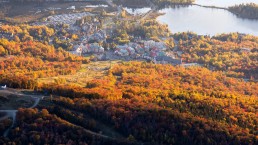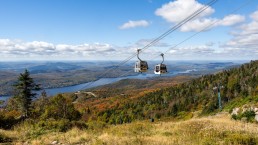Whether you’re here for skiing, hiking, or simply strolling through the pedestrian village, your stay in Tremblant offers much more than stunning scenery. In the forests, near trails, and around the lakes, the wildlife of the Laurentians is very much alive. Here are 10 wild animals you might spot during your time in Mont-Tremblant.
1. White-Tailed Deer
Majestic and graceful, the white-tailed deer—commonly called chevreuil in Quebec—is often seen at sunrise or sunset in the wooded areas surrounding Mont-Tremblant. Only males grow antlers, which they shed each winter and regrow in the spring.
Though shy, deer often leave signs of their presence: fresh tracks, tree rubs, or droppings along the trails. In the colder months, their movements become more predictable—a perfect time to observe them quietly.
Also read: Get to know the white-tailed deer

2. Wild Turkey
With its impressive size and prehistoric appearance, the wild turkey has made a strong comeback in the Laurentians. It prefers wooded areas bordered by fields and often roosts in trees at night in large groups.
In spring, the males fan their tail feathers and gobble loudly to attract females. They can run up to 20 km/h but rarely take flight. Avoid approaching them—keep a respectful distance.
3. Snapping Turtle
A hidden treasure in Tremblant’s wetlands, the snapping turtle is the largest freshwater turtle in Canada. It plays a vital role in maintaining ecosystem balance by feeding on dead plants and animals.
Quiet and elusive, it hibernates in mud during the winter and resurfaces with the warmer weather. Spotting one is rare but unforgettable—a true gem of Laurentian biodiversity worth protecting.
4. Groundhog
The groundhog hibernates deeply all winter, emerging in late February or early spring. You’ll often see it basking in sunny clearings or munching on fresh grass.
A diurnal creature, it’s frequently spotted near trails or even ski slopes in summer—especially on sunny spring days in Tremblant.
5. Snowshoe Hare & Eastern Cottontail Rabbit
In the forests around Tremblant, you might encounter two close cousins: the snowshoe hare, which turns white in winter, and the smaller eastern cottontail rabbit, which keeps its brown fur year-round.
The hare uses its large feet like snowshoes to glide over deep snow and evade predators. If you see twigs cut at a sharp angle or Y-shaped tracks in the snow during a hike, there’s likely a hare nearby.
6. North American Porcupine
Armed with 30,000 quills, the porcupine defends itself with powerful tail swipes. It’s a vegetarian, fond of buds, bark, and aquatic plants.
You might spot one climbing a tree, gnawing a branch, or even from the chairlift on the mountain. In winter, road salt attracts them dangerously close to traffic. Active year-round, they take shelter in hollow trees or rock crevices—even in the heart of a Laurentian winter.
7. Red Fox
Often seen on Tremblant’s golf courses, the red fox is a fascinating creature. Though part of the canine family, it shares several traits with felines—like retractable claws, stealthy movements, and even tree-climbing skills.
It comes in many color variations—red, black, silver—but always has a white-tipped tail and black legs. Curious, clever, and discreet, it often leaves behind fine tracks or narrow droppings in the snow.
8. Eastern Chipmunk
In the pedestrian village and surrounding woods, the eastern chipmunk—nicknamed petit suisse for its striped back—is busy stashing food in its cheek pouches.
It hibernates underground but occasionally wakes in winter to snack. Ever alert, it rarely ventures more than 100 meters from its burrow, ready to bolt at the slightest noise.
9. Raccoon
Recognizable by its black mask and ringed tail, the raccoon is called arakum by First Nations—meaning “the one who scratches with its hands,” which inspired the English word raccoon.
Mostly active at night, it searches streams for frogs, crayfish, and small fish. In winter, it enters a light torpor in a hollow shelter and may leave subtle tracks near Tremblant’s trails.
10. Gray, Black & Red Squirrels
These small, active rodents are ever-present around the Mont-Tremblant pedestrian village. The black squirrel, common here, thrives in winter thanks to its heat-absorbing dark coat.
The red squirrel is the noisiest of the bunch. In autumn, it creates large underground food caches, helping it survive in the snowy boreal forest.
Discover with kids : Animals of the Tam-Tam ski trail
BONUS: Birds of Tremblant
Tremblant is a haven for birdwatchers. You may spot the majestic bald eagle soaring over the lakes, or the pileated woodpecker (also called pic-bois), known for its red crest and tree-drilling insect hunts.
The stunning wood duck—one of North America’s most beautiful—nests in trees thanks to its gripping claws. At the Domaine Saint-Bernard, you’ll also hear black-capped chickadees, blue jays, warblers and woodpeckers. Bring a few seeds—they’re fed here all year long.

What About Wolves and Bears?
A common question: are there wolves or bears in Tremblant? Yes—but mainly within the Parc National du Mont-Tremblant, where these large mammals live far from populated areas.
The Eastern wolf plays a crucial role in ecosystem balance, while the black bear is shy and generally avoids humans. You probably won’t encounter these animals in the pedestrian village or on ski trails, but their presence is vital to the region’s natural richness.
To learn more, visit the park’s discovery centers—they offer fascinating insights into these iconic Laurentian species.
PLEASE DO NOT FEED THE ANIMALS
While it may seem kind, feeding wild animals harms their health, disrupts natural behavior, and threatens the fragile balance of our ecosystem. Coexisting with wildlife means respecting it in its natural habitat. Let’s admire them—without trying to tame them.
Plan Your Fall Colours Visit
To make the most of the fall colours during the weekends from September 20 to October 13, please note the following traffic measures:
- Enhanced free public transit, available at all times
- Parking P1 to P5: $20 for cars, $10 for motorcycles, $30 for recreational vehicles
- North Side parking (from Sept. 27): $10, 1,000 spaces, direct shuttle from 9 a.m (outdoor toilets only)
- No parking permitted on Chemin Duplessis or along the Resort













